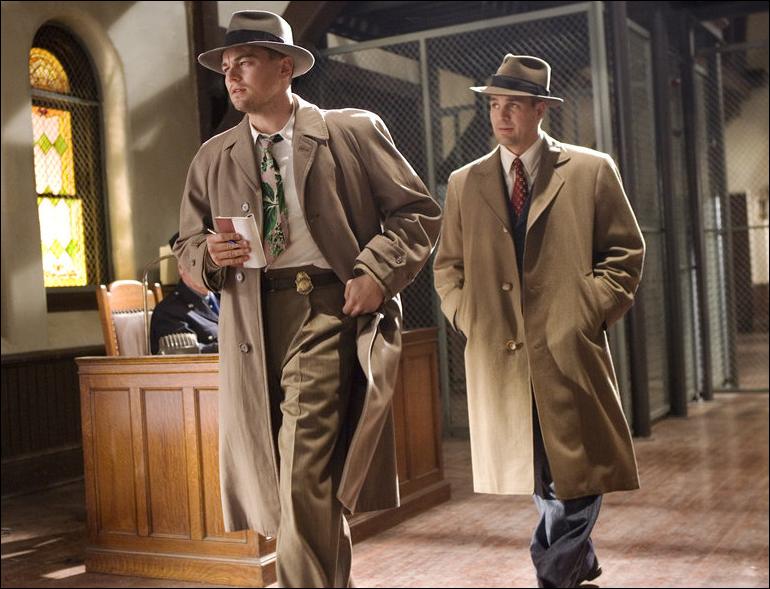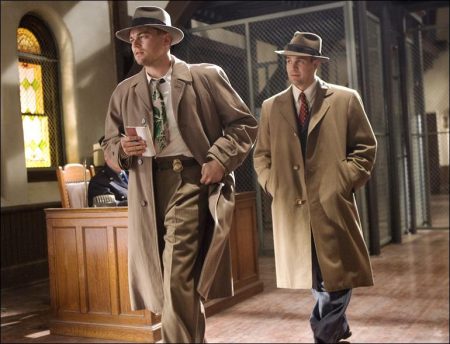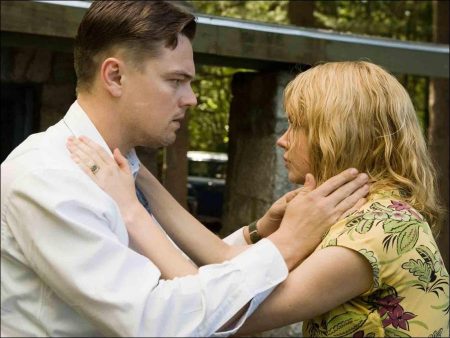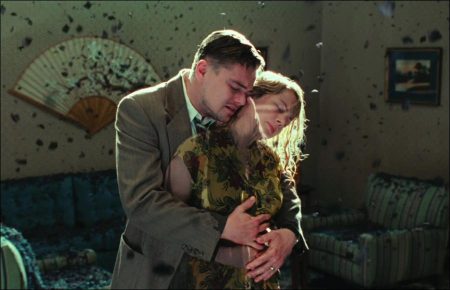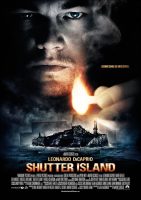Taglines: Somenone is missing.
The year is 1954, at the height of the Cold War, when U.S. Marshal Teddy Daniels (Leonardo DiCaprio) and his new partner Chuck Aule (Mark Ruffalo) are summoned to Shutter Island to investigate the implausible disappearance of a brilliant multiple murderess from a locked room within the impenetrable Ashecliffe Hospital. Surrounded by probing psychiatrists and dangerously psychopathic patients on the remote, windswept isle, they arrive into an eerie, volatile atmosphere that suggests nothing is quite what it seems.
With a hurricane bearing down on them, the investigation moves rapidly. Yet, as the storm escalates, the suspicions and mysteries multiply each more thrilling and terrifying than the next. There are hints and rumors of dark conspiracies, sordid medical experiments, repressive mind control, secret wards, perhaps even a hint of the supernatural, but elusive proof. Moving in the shadows of a hospital haunted by the terrible deeds of its slippery inhabitants and the unknown agendas of its equally ingenious doctors, Teddy begins to sense that the deeper he pursues the investigation the more he will be forced to confront some of his most profound and devastating fears. And he realizes that he may never leave the island alive.
Shutter Island is an American psychological thriller film directed by Martin Scorsese. The film is based on Dennis Lehane’s 2003 novel of the same name. Production started in March 2008. Leonardo DiCaprio stars as U.S. Marshal Edward “Teddy” Daniels, who is investigating a psychiatric facility on Shutter Island. Positively cited by movie reviewers, the film grossed over $128 million in its initial domestic theater release, as well as an additional $166 million internationally. Shutter Island was originally slated to be released on October 2, 2009, but Paramount Pictures pushed the release date to February 19, 2010.
About the Production
The rights to Dennis Lehane’s novel Shutter Island were first optioned to Columbia Pictures in 2003. Columbia did not act on the option and it lapsed back to Lehane who sold it to Phoenix Pictures. Phoenix hired Laeta Kalogridis and together they developed the film for a year. Director Martin Scorsese and actor Leonardo DiCaprio were both attracted to the project. Production began on March 6, 2008. Lehane’s inspiration for the hospital and island setting was Long Island in Boston Harbor, which he had visited during the Blizzard of 1978 as a child with his uncle and family.
Shutter Island was mainly filmed in Massachusetts, with Taunton being the location for the World War II flashback scenes.[9] Old industrial buildings in Taunton’s Whittenton Mills Complex replicated the Dachau concentration camp.[10] The old Medfield State Hospital in Medfield, Massachusetts was another key location. Cawley’s office scenes were the second floor of the chapel during the late evening. Lights were shone through the windows to make it look like it was daytime. The crew painted the hospital’s brick walls to look like plywood.
Journey to Shutter Island
Shortly after completing his novel Mystic River, which would go on to become an Academy Award®-winning film directed by Clint Eastwood, writer Dennis Lehane radically shifted gears. Moving away from the gritty, blue-collar, Boston settings for which he was best known, Lehane fashioned an intensely atmospheric, terror-filled psychological shocker set at the height of 1950s Cold War paranoia, and at the crossroads where the lines between sanity and madness, truth and delusion begin to blur beyond recognition.
This was Shutter Island, which merged elements of Gothic mystery, pulp fiction, conspiracy thrillers and turn-of the-screws, Edgar Allan Poe-style horror to create a riveting and unsettling effect that took his readers by surprise. Unfolding over just four searing days at the island-based Ashecliffe Hospital for the Criminally Insane, in the midst of a raging Category 5 hurricane, the book presented a most unusual criminal investigation, one that was completely cut off from the outside world and in which the vise keeps tightening on the two lone investigators, ultimately forcing U.S. Marshal Teddy Daniels to come face-to-face with a realm in which the human psyche has run dangerously amok, as well as harrowing secrets, frightening memories and deeply buried truths.
The book hinged on the riddle of a murderess’ inconceivable, mystifying disappearance from the high-security facility, but within its labyrinth of eerie twists and turns it touched on such topics as the lingering trauma of World War II, the 20th century’s potential for vast conspiracies, the debate over invasive psychiatric treatments and, most of all, on the extraordinary power of the human psyche, in spite of all scientific and legal efforts, to elude even the best efforts to bring it under control.
Writing in The New York Times, Janet Maslin called the book “startlingly original” and “instantly cinematic” and it went on to become one of the best-sellers of 2003. Producer Bradley J. Fischer, a partner at Phoenix Pictures who was then producing David Fincher’s thriller about a real-life serial murderer, Zodiac, picked the book off an airport kiosk and found himself so transported by its anxietysoaked atmosphere and web of contemporary themes, he immediately wanted to bring it to the screen.
“I’d been a big fan of Dennis Lehane, yet I wasn’t prepared for this novel,” recalls Fischer. “It’s a thriller and a Gothic mystery, but there is also much more to it because it has so much depth and deals with serious moral issues. The dense, atmospheric plot features a series of twists and turns that leaves you reeling and is quite mind-blowing.”
As soon as he could acquire the rights, Fischer jumped into action, along with company head Mike Medavoy. Also coming on board as a producer was Phoenix Pictures executive Arnold W. Messer.
Fischer approached Laeta Kalogridis, a screenwriter known for her strong affinity to suspense, adventure and depth of character. Having previously worked with Kalogridis on the Viking-era action thriller Pathfinder, the producers at Phoenix knew she had the creative potential to realize this challenging material. “We felt Laeta would be able to take Dennis Lehane’s brilliant words and make them come to life in a truly cinematic way,” says Fischer.
Kalogridis, who is also one of the executive producers on Shutter Island (along with Chris Brigham, Lehane, Gianni Nunnari and Louis Phillips), was thrilled by the challenge of working with the richly woven fabric of Lehane’s story, which sinuously weaves its way through flashbacks, hallucinations and fantasies, playing with chronological time and the elusive nature of moment-to-moment reality. She immersed herself in the project, exploring the broad range of unsettling topics that Lehane raises, from the horror-filled past of insane asylums, to the dark science behind prefrontal-lobe lobotomies, to such historical terrors as Nazi concentration camps and Cold War-era mind control experiments.
“Laeta was as stunned as I was by the story,” comments Fischer. “She saw that the narrative has all these different threads and layers that needed to be balanced – not an easy adaptation – but she carefully explored different directions for the characters and ways to bring in the flashbacks. We soon had a screenplay that Mike Medavoy and I were very happy with.”
Even more so than Lehane’s novel, which the author has said was inspired in part by his love of B movies, the screenplay brought to mind a pantheon of classic Hollywood movies, including Otto Preminger’s identity-shifting mystery Laura and Sam Fuller’s mental asylum exposé Shock Corridor. It was clear that doing it justice would require a director of particularly deep cinematic knowledge and an abiding love of psychological interplay.
The first name that came to Fischer’s mind was Academy Award-winning director Martin Scorsese. It was on a wing and a prayer that the Phoenix executives approached the prolific, almost-always engaged director because they assumed that, fresh off his Best Director Oscar win for the electrifying crime thriller The Departed, he would be a long shot.
But their timing couldn’t have been better. Scorsese was not only available but passionate about the style and themes of Shutter Island. When Phoenix sent him the script, he was in the thick of narrating the documentary Val Lewton: The Man in the Shadows, a documentary about the distinctive creative force behind such hugely influential and wondrously ominous 1940s RKO horror films as Cat People and I Walked with a Zombie.
Scorsese was in the mood for a modern take on existentially-complicated terror. “Marty was attracted to the idea of taking on a Gothic horror tale that’s shrouded in shadow and mystery,” Fischer explains. “He jumped on the idea and his excitement was enormous from the get-go. When I got the call from Marty’s agent saying he wanted to direct Shutter Island, he told me, ‘Marty says it reminds him of this old German movie called….called…’ While he tried to recall the title, I happened to be staring across my office at a framed poster of the very film, one of my favorites, a classic silent from the Expressionist era of German cinema. ’He said it reminded him of The Cabinet of Dr. Caligari,’ I suggested. ‘Yes,’ the agent shouted. ‘That’s it!’”
Fischer continues: “Learning that the script evoked for Marty thoughts of the same old Weimar-period horror film that it did for me was overwhelming. Yet, I wasn’t surprised. The Cabinet of Dr. Caligari is a film that always bore some similarities in my mind to Shutter Island. It’s a film that Marty admires and one of many he would reference throughout shooting. From this point, things started moving very quickly. The things Marty saw in the story and all the levels he found in the material made the project so much richer than any of us had ever imagined.”
Scorsese says it was his first read of the Shutter Island script that hooked him. “I didn’t know anything about the story and I started reading it at about 10:30 at night and I needed to go to bed because I had to get up early the next day, but I found I could not put the script down and was constantly surprised by the different levels of the story,” he recalls.
He felt an instant link to the story’s mix of classic thriller genres, from shadowy noir to boldface horror. “This is the type of picture I like to watch, the kind of story I like to read,” Scorsese explains. “Over the years, I think I’ve stayed away from certain kinds of pictures that emulate the style that I find nurturing in a way, but these are the kinds of films I go back to and view repeatedly. I’ve always been drawn to this sort of story. What’s interesting to me is how the story keeps changing, and the reality of what’s happening keeps changing, and how up until the very final scene, it’s all about how the truth is perceived.”
He continues: “But more than the way the story is told or the setting, for me, it’s really about what happens to the character of Teddy, which I found to be very moving. That was the emotional connection.”
Scorsese’s approach utilized the noir-like surfaces of Kalogridis’ adaptation to get at the deeper micro-dynamics and psychological machinations of the characters, fusing richly cinematic visuals with underlying emotions to lure the audience out on a thrillingly fragile edge along with Teddy Daniels. Right from the start of production, the director inspired cast and crew with a series of nighttime screenings of films, both legendary and obscure, that touched upon the themes and styles woven through Shutter Island.
Among Scorsese’s choices were Preminger’s Laura; Jacques Tourneur’s 1947 dark noir tale of double-crosses, Out of the Past; Edward Dmytryk’s 1947 thriller Crossfire, about the murder of a Jewish soldier after WWII; Nicholas Ray’s 1952 police drama On Dangerous Ground; Karl Malden’s 1957 directorial debut, Time Limit, an intensely psychological courtroom drama about an American soldier facing a court martial; Orson Welles’ 1963 The Trial, the screen adaptation of Franz Kafka’s surreal tale of a man inexplicably detained for an unknown crime; John Huston’s wartime documentaries San Pietro and Let There Be Light, the latter about returning soldiers suffering from what was then dubbed “shell shock”; influential horror films including Robert Wise’s The Haunting and Jack Clayton’s The Innocents; and several of the Val Lewton films so essential to Scorsese’s appreciation of the horror thriller genre, including the shadowy The Seventh Victim, about a woman searching for her missing sister amidst a Satanic cult.
An essential documentary was also included in the lineup: Frederick Wiseman’s controversial and, at one time, banned 1967 movie exploring the treatment of inmates at a hospital for the criminally insane called Titicut Follies, which gave the cast and crew a harrowing insight into what asylums were really like in the ‘50s and ‘60s, before modern reforms improved conditions and made patients’ rights a priority. Set inside the Massachusetts Correctional Institute for the Criminally Insane at Bridgewater, the film unflinchingly depicted a treatment facility in which patients were stripped naked, chained to their cell walls, force-fed and deprived of basic human dignity. The film would have a major impact. Soon after its release, public outrage was so widespread that a class-action suit was brought against Bridgewater, which in turn led to changes in the way state institutions were run across the country.
“Watching Titicut Follies allowed the cast and crew to see firsthand the kind of world the film would be portraying,” notes Fischer. “It was a very powerful experience for all of us.”
Shutter Island (2010)
Directed by: Martin Scorsese
Starring: Leonardo DiCaprio, Mark Ruffalo, Ben Kingsley, Michelle Williams, Max von Sydow, Emily Mortimer, Jackie Earle Haley, Patricia Clarkson, Robin Bartlett, Nellie Sciutto, Elias Koteas
Screenplay by: Laeta Kalogridis
Production Design by: Dante Ferretti
Cinematography by: Robert Richardson
Film Editing by: Thelma Schoonmaker
Costume Design by: Sandy Powell
Set Decoration by: Francesca Lo Schiavo
Art Direction by: Max Robert Guerra, Christina Ann Wilson
MPAA Rating: R for disturbing violent content, language and some nudity.
Distributed by: Paramount Pictures
Release Date: February 19, 2010
